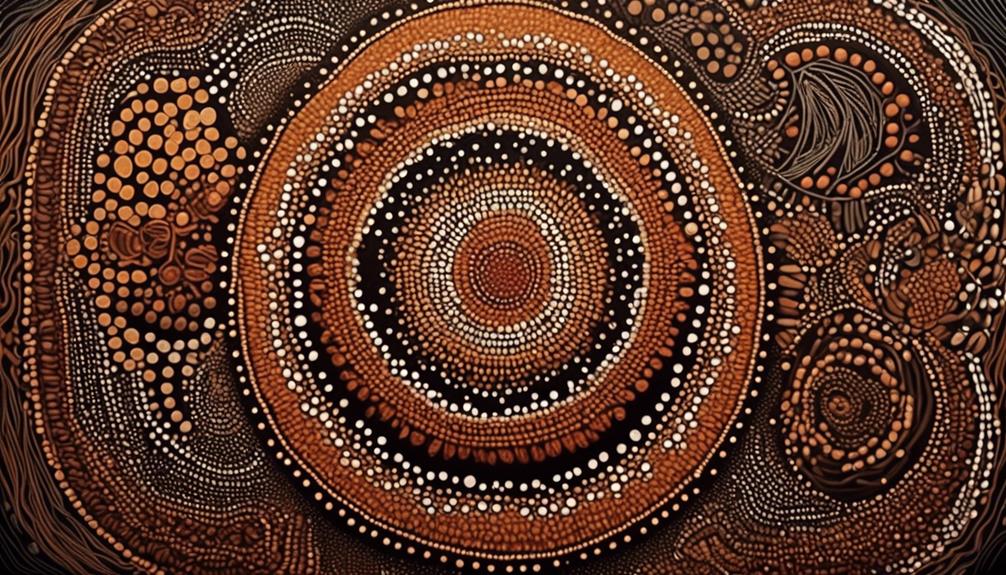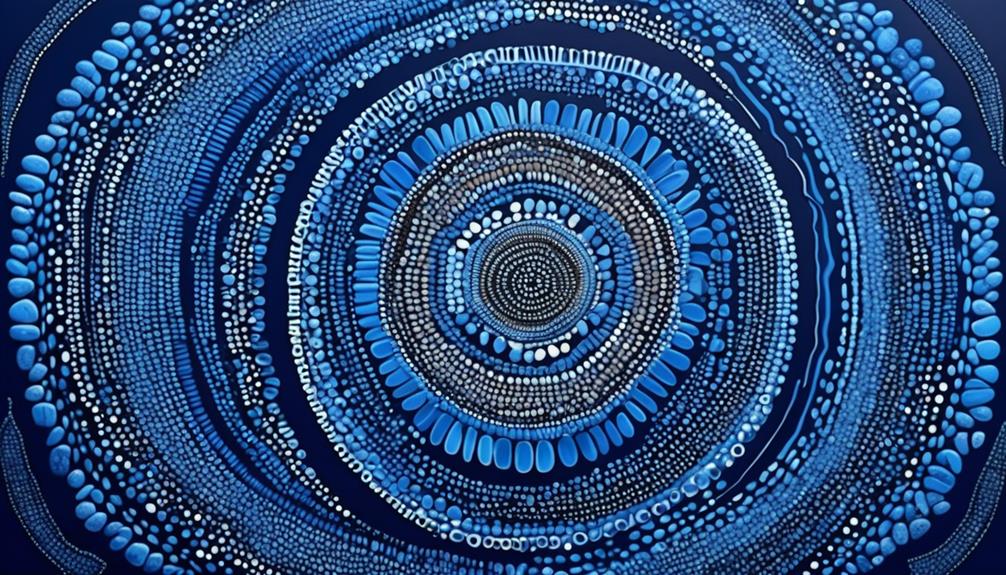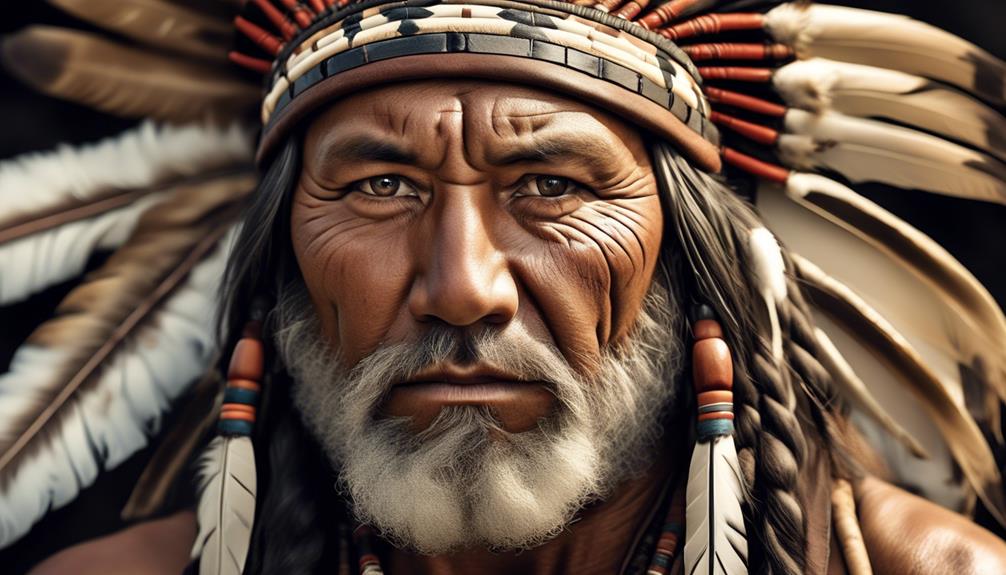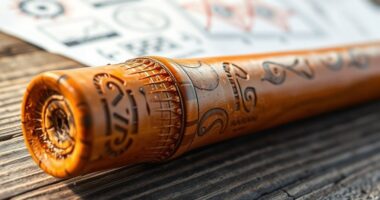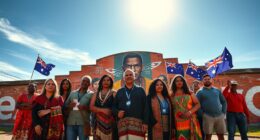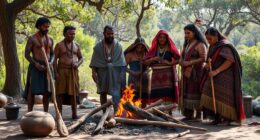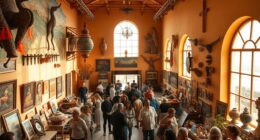Are you interested in exploring the intricate and symbolically meaningful world of Indigenous body art? This longstanding tradition holds significant cultural value and has been practiced for centuries.
From the traditional techniques passed down through generations to the spiritual meanings embedded in each design, Aboriginal body art offers a fascinating window into the history and beliefs of indigenous communities.
As you explore this ancient form of expression, you'll uncover a world of artistry and tradition that continues to evolve and captivate to this day.
Key Takeaways
- Aboriginal body art is deeply rooted in ancient cultural practices and is intertwined with spiritual beliefs and social customs.
- It serves multiple purposes and reflects the rich cultural heritage of Aboriginal communities, being an integral part of rituals, ceremonies, and rites of passage.
- Aboriginal body art symbolizes connections with the land, ancestors, and the Dreamtime, representing the spiritual forces and beliefs of the indigenous communities.
- The techniques and tools used in Aboriginal body art include natural pigments derived from clay, charcoal, and ochre, as well as sticks, feathers, and brushes made from natural materials. Different techniques such as hand-stippling, dotting, and line work are employed by different groups.
Historical Roots of Aboriginal Body Art
The historical roots of Aboriginal body art can be traced back to ancient cultural practices that were deeply intertwined with spiritual beliefs and social customs. Traditional practices of body art among Aboriginal communities served multifaceted purposes, reflecting their rich cultural heritage.
Historically, body art wasn't merely ornamental but held significant spiritual and cultural meanings. It was an integral part of rituals, ceremonies, and rites of passage, symbolizing connections with the land, ancestors, and the Dreamtime. These intricate designs and markings were a way of expressing identity, kinship, and social status within the community.
In contrast to Western body art, such as tattoos, Aboriginal body art was deeply ingrained in the cultural and spiritual fabric of their societies. It was a visual language that conveyed stories, traditions, and knowledge, often passed down through generations.
Understanding the historical origins of Aboriginal body art provides insight into the complexity and depth of their traditional practices, offering a lens through which to appreciate the significance of this art form within Indigenous cultures.
Symbolism and Meanings in Body Art
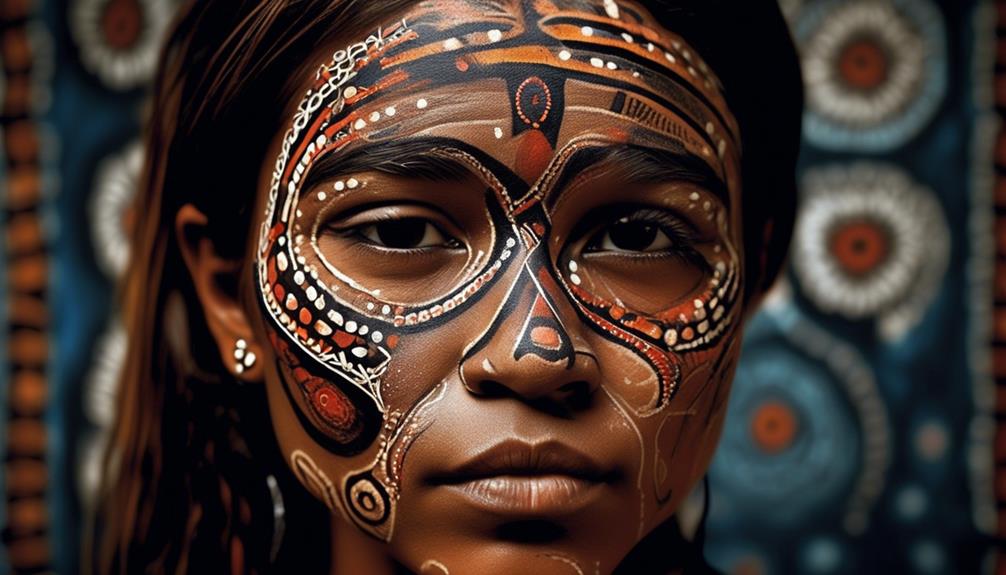
Exploring the symbolism and meanings embedded in Aboriginal body art unveils a rich tapestry of cultural significance and spiritual depth that transcends mere aesthetic adornment. In Aboriginal culture, body art serves as a symbolic representation of the interconnectedness between the physical and spiritual realms. Each symbol and design holds profound cultural significance, often tracing lineage, clan affiliation, and spiritual beliefs.
For instance, the use of specific animal totems in body art represents a connection to the natural world and embodies the qualities and characteristics of the chosen animal, such as strength, wisdom, or resilience.
Furthermore, Aboriginal body art also conveys narratives of creation, ancestral stories, and sacred rituals. The intricate patterns and designs aren't merely decorative but are imbued with layers of meaning that reflect the depth of Aboriginal spirituality and cultural heritage.
Comparatively, the symbolism in Aboriginal body art can be likened to the hieroglyphs of ancient Egypt or the intricate motifs in traditional Japanese tattoos, both serving as visual representations of cultural and spiritual significance.
Understanding the symbolism and meanings in Aboriginal body art provides a gateway to appreciating the profound cultural legacy and spiritual wisdom encapsulated in these unique forms of artistic expression.
Techniques and Tools for Body Art
As you delve into the techniques and tools for creating Aboriginal body art, you'll discover a world rich in tradition, craftsmanship, and cultural significance. Body painting is a central aspect of many Aboriginal cultural traditions and is often used for ceremonial purposes, storytelling, and as a form of body adornment.
The process of body painting involves the use of natural pigments derived from materials such as clay, charcoal, and ochre. These pigments are then mixed with various mediums such as water, animal fats, or plant extracts to create a paint that can be applied to the skin.
Traditionally, the tools for applying body paint include items such as sticks, feathers, and brushes made from natural materials such as wood, bone, or hair. The techniques for creating intricate designs and patterns vary among different Aboriginal groups, with some using hand-stippling, dotting, or line work to achieve stunning visual effects.
The precision and skill required to execute these techniques reflect the mastery and expertise passed down through generations, making Aboriginal body art a testament to the rich cultural heritage and artistic prowess of Indigenous communities.
Spiritual and Cultural Significance
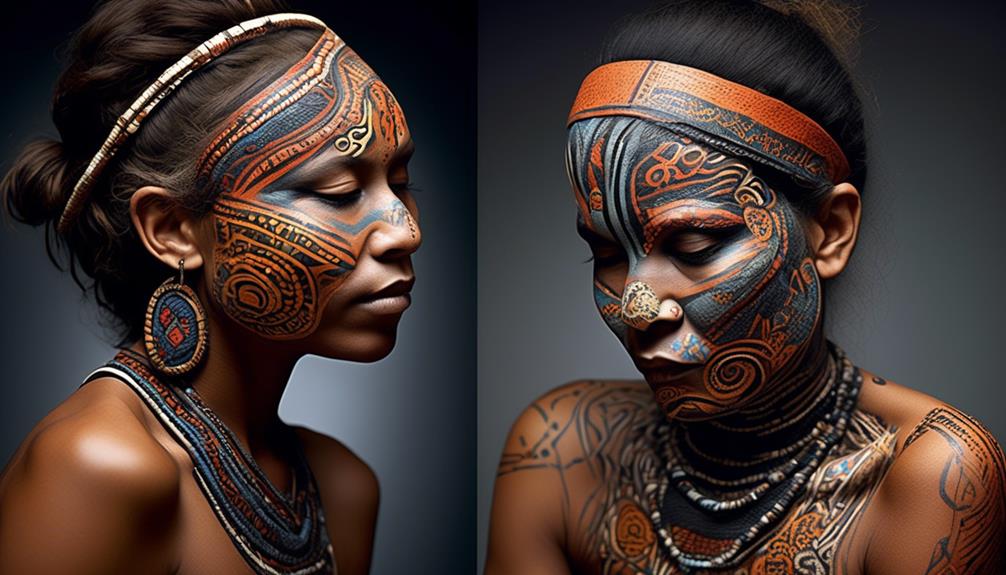
When considering the spiritual and cultural significance of Aboriginal body art, one can appreciate the deep-rooted connections to ancestral traditions and storytelling. The body art holds immense spiritual importance, often serving as a medium for connecting with the spiritual realm and ancestors.
It's a representation of the Dreamtime, the Aboriginal understanding of the world, its creation, and the spiritual forces that govern it. The intricate designs and patterns used in body art reflect the rich tapestry of Aboriginal spiritual practices and traditional customs, each carrying profound meaning and symbolism.
Through body art, individuals engage in a spiritual journey, connecting with their roots, ancestors, and the natural world. This practice fosters a profound sense of belonging and identity within the community, contributing to the preservation and continuation of traditional customs.
The act of adorning the body with these sacred designs is a way of embodying the stories, knowledge, and wisdom passed down through generations, making it an integral part of Aboriginal cultural expression and spirituality.
Evolution of Aboriginal Body Art
The deep-rooted spiritual and cultural significance of Aboriginal body art lays the foundation for understanding its evolution through time, revealing a rich tapestry of transformation and adaptation. As cultural influences have shifted and blended, the evolution of Aboriginal body art has taken on new forms and meanings, reflecting the dynamic nature of indigenous cultures. Modern adaptations have emerged, honoring traditional practices while also embracing contemporary influences.
- Cultural Influences: Over time, interactions with other cultures, colonization, and globalization have impacted the evolution of Aboriginal body art, leading to the incorporation of new symbols, techniques, and styles.
- Interconnectedness with Nature: The evolution of Aboriginal body art continues to be influenced by the interconnectedness with nature, with modern adaptations reflecting a deep respect for the environment and its preservation.
- Revival of Traditional Techniques: Despite modern influences, there's been a revival of traditional techniques, showcasing a resurgence of ancient practices in contemporary Aboriginal body art.
- Expression of Identity: The evolution of Aboriginal body art serves as a powerful expression of indigenous identity, navigating the complexities of modern society while preserving cultural heritage.
Frequently Asked Questions
What Are the Most Common Natural Materials Used in Traditional Aboriginal Body Art?
The most common natural materials used in traditional Aboriginal body art include natural pigments like ochre, charcoal, and clay. Indigenous traditions have long utilized these materials to create traditional designs with deep cultural significance.
These natural pigments aren't only used for body art but also in various cultural ceremonies and rituals. The vibrant colors and distinct patterns carry significant meanings within the Aboriginal community, reflecting their rich cultural heritage and connection to the land.
How Do Different Aboriginal Communities Vary in Their Approach to Body Art Techniques and Designs?
In different Aboriginal communities, body art techniques and designs vary greatly, reflecting the rich cultural diversity within each group.
These variations aren't just stylistic but are deeply rooted in the cultural significance of the designs and the traditional materials used.
As communities adapt to modern influences, there are also contemporary interpretations of these traditional practices.
The intricate differences in techniques and designs across communities offer a fascinating glimpse into the diversity of Aboriginal culture.
Are There Specific Rituals or Ceremonies Associated With the Application of Aboriginal Body Art?
In various indigenous cultures, specific rituals or ceremonies are deeply intertwined with their traditions and practices. These rituals hold immense cultural significance and often involve spiritual symbolism. They're integral to the community's identity and are passed down through generations, fostering a strong sense of connection and belonging.
The application of body art during these rituals serves as a powerful expression of their heritage and plays a vital role in their ceremonies.
How Has Contemporary Society Influenced the Practice and Meaning of Aboriginal Body Art?
In today's globalized world, the influence of contemporary society has reshaped traditional practices, leading to appropriation in body art.
This phenomenon mirrors the clash of cultures, with globalization often diluting the authentic meaning behind indigenous art.
As a result, the practice of Aboriginal body art has been impacted by societal shifts, blurring the lines between cultural appreciation and appropriation.
It's crucial to navigate these complexities with respect and understanding.
What Role Do Elders and Community Leaders Play in the Preservation and Continuation of Traditional Aboriginal Body Art Practices?
Elders and community leaders are crucial in preserving traditional practices. Their guidance ensures that cultural variation is maintained and that the use of natural materials continues.
In the face of contemporary influence, their role becomes even more vital, as they uphold the authenticity of traditional practices.
Their knowledge and experience also provide invaluable insight for future generations, ensuring that the legacy of traditional Aboriginal body art remains intact.
Conclusion
As you reflect on the intricate designs of Aboriginal body art and the deep cultural meanings they hold, it's like discovering a hidden language etched onto the skin. Just as each stroke and pattern tells a unique story, the evolution of Aboriginal body art is a testament to the resilience and creativity of Indigenous cultures.
The techniques and symbolism used in this art form offer a window into the rich history and spiritual beliefs of Aboriginal peoples, creating a timeless connection between past and present.
